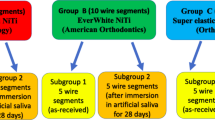Abstract
The aim of this paper is to analyze the influence of the nature of the orthodontic archwires on the friction coefficient and wear rate against materials used commonly as brackets (Ti–6Al–4V and 316L Stainless Steel). The materials selected as orthodontic archwires were ASI304 stainless steel, NiTi, Ti, TiMo and NiTiCu. The array archwire’s materials selected presented very similar roughness but different hardness. Materials were chosen from lower and higher hardness degrees than that of the brackets. Wear tests were carried out at in artificial saliva at 37 °C. Results show a linear relationship between the hardness of the materials and the friction coefficients. The material that showed lower wear rate was the ASI304 stainless steel. To prevent wear, the wire and the brackets have high hardness values and in the same order of magnitude.




Similar content being viewed by others

References
Daems J, Celis JP, Willems G. Morphological characterization of as-received and in vivo orthodonti11c stainless steel archwires. Eur J Orthod. 2009;31:260–5.
Verstrynge A, van Humbeeck J, Willems G. In-vitro evaluation of the material characteristics of stainless steel and beta-titanium orthodontic wires. Am J Orthod Dentofac Orthop. 2006;130:460–70.
Schiff N, Grosgogeat B, Lissac M, Dalard F. Influence of fluoridated mouthwashes on corrosion resistance of orthodontic wires. Biomaterials. 2004;25:4535–42.
Kim H, Johnson JW. Corrosion of stainless steel, nickel–titanium, coated nickel–titanium, and titanium orthodontic wires. Angle Orthod. 1999;69:39–44.
Pereira MC, Pereira ML, Sousa JP. Histological effects of iron accumulation on mice liver and spleen after administration of a metallic solution. Biomaterials. 1999;20:2193–8.
Bourauel C, Fries T, Drescher D, Plietsch R. Surface roughness of orthodontic wires via atomic force microscopy, laser specular reflectance, and profilometry. Eur J Orthod. 1998;20:79–92.
Schiff N, Boinet M, Morgon L, Lissac M, Dalard F, Grosgeat B. Galvanic corrosion between orthodontic wires and brackets in flouride mouthwashes. Eur J Orthod. 2006;28:298–304.
Oh KT, Kim KN. Ion release and citotoxicity of stainless steel wires. Eur J Orthod. 2005;27:533–40.
Fischer-Brandies H, Es-Souni M, Kock N, Raetzke K, Bock O. Transformation behavior, chemical composition, surface topography and bending properties of five selected 0.016 × 0.022″ NiTi archwires. J Orofac Orthop. 2003;64:88–99.
Ogawa T, Yokoyama K, Asaoka K, Sakai J. Hydrogen absorption behavior of beta-titanium alloy in acid fluoride solutions. Biomaterials. 2004;25:2419–25.
Espinar E, Llamas JM, Michiardi A, Ginebra MP, Gil FJ. Reduction of Ni release and improvement of the friction behavior of NiTi orthodontic archwires by oxidation treatments. J Mater Sci Mater Med. 2011;22:1119–25.
Suárez C, Vilar T, Gil J, Sevilla P. In vitro evaluation of surface topographic changes and nickel release of lingual orthodontic archwires. J Mater Sci Mater Med. 2010;21:675–83.
Michiardi A, Aparicio C, Planell JA, Gil FJ. New oxidation treatment of NiTi shape memory alloys to obtain Ni-free surfaces and to improve biocompatibility. J Biomed Mater Res Appl Biomat. 2006;77B:249–56.
Gil FJ, Solano E, Mendoza A, Peña J. Inhibition of Ni release from NiTi and NiTiCu orthodontic archwires by nitrogen diffusion treatment. J Appl Biomater Biomech. 2004;2:151–5.
Kerosuo H, Kullaa A, Kerosuo E, Kanerva L, Hensten-Petterson A. Nickel allergy in adolescents in relation to orthodontic treatment and piercing of ears. Am J Orthod Dentofac Orthop. 1996;109:148–54.
Berger-Gorbet M, Broxup B, Rivard C. L’H. Yahia. Biocompatibility testing of Ni-Ti screw using immuno histochemistry on sections containing metallic implants. J Biomed Mater Res. 1996;32:243–8.
International Agency for Research on Cancer. Monographs on the evaluation of carcinogenic risk of chemicals to humans. Lyon: IARC; 1996.
Grimsdottir MR, Hensten-Pettersen A, Kulmann A. Cytotoxic effect of orthodontic appliances. Eur J Orthod. 1992;14:47–53.
Kusy RP. Orthodontic biomechanics: vistas from the top of a new century. Am J Orthod Dentofac Orthop. 2000;117:589–91.
Thorstenson GA, Kusy RP. Effect of archwire size and material on the resistance to sliding of self-ligating brackets with second-order angulation in the dry state. Am J Orthod Dentofac Orthop. 2002;122:295–305.
Kusy RP. Influence on binding of third-order torque to second-order angulation. Am J Orthod Dentofac Orthop. 2004;125:726–32.
Griffiths HS, Sherriff M, Ireland AJ. Resistance to sliding with 3 types of elastomeric modules. Am J Orthod Dentofac Orthop. 2005;127(670–675):754.
Marques IS, Araújo AM, Gurgel JA, Normando D. Debris, roughness and friction of stainless steel archwires following clinical use. Angle Orthod. 2010;80(3):521–7.
Umal H, Doshia A, Bhad-Patil WA. Static frictional force and surface roughness of various bracket and wire combinations. Am J Orthod Dentofac Orthop. 2011;139:74–9.
Gal J, Fovet Yannick, Adib-Yadzi M. About a synthetic saliva for in vitro studies. Talanta. 2001;53:1103–15.
Boyer R, Welsch GW, Collings EW. Materials properties handbook:titanium alloys. Ohio: ASM; 1994. p. 125–30.
Normando D, de Araújo AM, da Silva Vieira IS, Gilda C, Tavares B, Mendes JA. Archwire cleaning after intraoral ageing: the effects on debris, roughness, and friction. Eur J Orthod Adv. 2011;19:201–17.
Acknowledgments
The authors are grateful to the CICYT MAT 13547 and Generalitat de Catalunya and Andorra Government (CTP project) for funding the present study. The authors do not have conflict of interest associated with this study.
Author information
Authors and Affiliations
Corresponding author
Rights and permissions
About this article
Cite this article
Alfonso, M.V., Espinar, E., Llamas, J.M. et al. Friction coefficients and wear rates of different orthodontic archwires in artificial saliva. J Mater Sci: Mater Med 24, 1327–1332 (2013). https://doi.org/10.1007/s10856-013-4887-4
Received:
Accepted:
Published:
Issue Date:
DOI: https://doi.org/10.1007/s10856-013-4887-4



